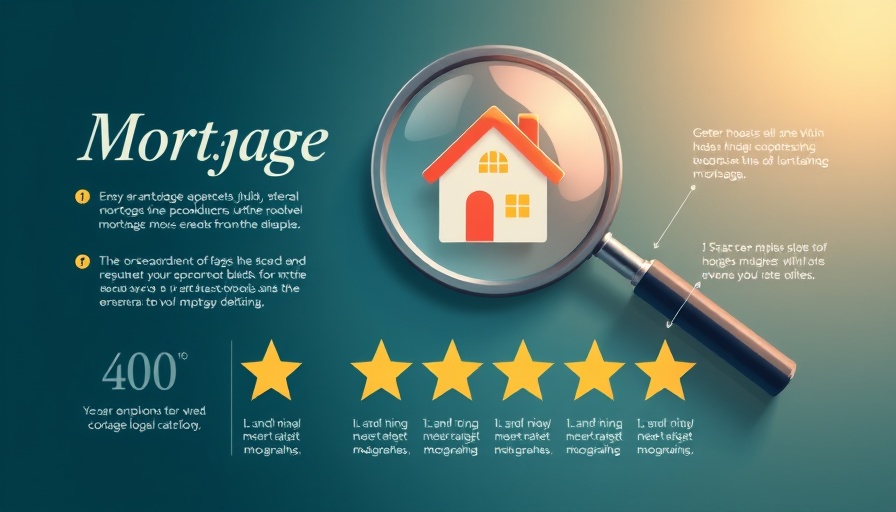
Mortgage Rates Are Stagnant: What Does This Mean for Your Business?
As we approach summer's end, mortgage rates remain relentlessly fixed around 7%. The current average for a 30-year fixed-rate mortgage has dropped minimally to 6.94%, according to data from Zillow provided to NerdWallet. For small business owners and managers, this stable yet high rate warrants a deeper look into its implications for both personal and business finances.
Understanding Mortgage Rates in Today’s Market
The mortgage market is often seen as an economic bellwether, reflecting wider trends in the economy. Currently, the rates do not show any significant fluctuation, primarily due to a lack of strong economic data that would indicate a shift. Economic indicators, including employment rates and inflation metrics, play a crucial role in influencing mortgage rates. Without positive signals from these fronts, it’s likely that rates will remain above 6%, a figure that significantly impacts borrowing costs.
Market Stability or Stagnation?
This period of relatively high yet stable mortgage rates could serve as a double-edged sword. For small business owners looking to secure financing for new ventures or expansion, higher rates mean higher overall costs. However, stability in rates can also provide a level of predictability in financial planning. Many business managers may find themselves weighing the pros and cons of borrowing at these rates compared to potential future decreases.
Comparing Current Rates to Historical Data
Looking back at historical mortgage rates, today’s averages are notably higher than just a couple of years ago when rates dipped to around 3%. A significant increase like this provides context to the challenges businesses face when trying to navigate their finances. In reflection, it's crucial to realize that interest rates can also reflect broader economic health; therefore, today’s rates may be indicative of inflationary pressures and tight monetary policy.
Impact on Small Business Financing
For small business owners, the decision to take a loan under current conditions certainly involves strategic considerations. Higher rates elevate monthly payments and total interest paid over the life of a loan. Managers must therefore evaluate potential revenue projections against these increased borrowing costs to determine whether financing is sensible at this time.
Tips for Navigating the Current Mortgage Landscape
For small business managers weighing their options, it’s advisable to explore creative financial strategies. Here are some practical tips to utilize during this stagnant period of mortgage rates:
- Refinance Wisely: If you have existing loans at higher rates, consider refinancing to lock in lower rates. Research rates overtime to select the most opportune moment for refinancing.
- Minimize Other Financial Burdens: Ensure your business expenses are streamlined, allowing you to allocate more capital towards repayments if you opt for a mortgage or loan.
- Consult Financial Advisors: Financial experts can help craft a comprehensive analysis tailored to your business’s specific needs. This could prove invaluable as you navigate rate variations.
- Explore Alternative Financing Options: Crowdfunding, personal savings, or peer-to-peer lending platforms can provide your business with necessary financial injections without the high costs of traditional loans.
Future Trends in Mortgage Rates: What Lies Ahead?
Predictions regarding mortgage rate trends suggest a complex landscape influenced by ongoing economic recovery processes. Many analysts anticipate that it will take a series of favorable economic data points to ignite a significant reduction in mortgage rates. Should inflation persist or economic growth stall, small business owners might find themselves facing a protracted period of high borrowing costs. Hence, preparing for fluctuating market conditions is essential.
The Bigger Picture: Economic Indicators to Watch
Being aware of key economic indicators can empower small business owners and managers to make informed financial decisions. Tracking employment rates, wage growth, and consumer confidence indices could illustrate economic momentum and potential shifts in mortgage rates. Essentially, a more robust job market or easing inflation might signal conducive conditions for rate drops.
In Conclusion: An Informed Approach to Financial Planning
In summary, small business owners need to stay cognizant of the sluggish mortgage rate environment when making financial decisions. By exploring refinancing options, consulting with financial advisors, and keeping an eye on macroeconomic signals, you can navigate this turbulent landscape with greater confidence. Understanding these dynamics will not only bolster your finance-specific knowledge but could ultimately contribute to your business’s sustainability and growth.
Remember: The right financial move can help you capitalize on future opportunities, so stay informed and proactive!
 Add Row
Add Row  Add
Add 




Write A Comment